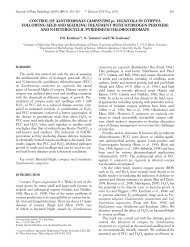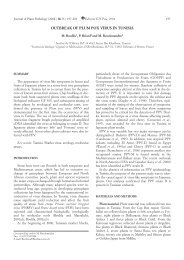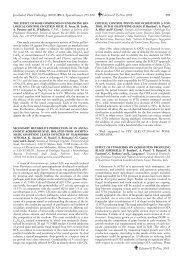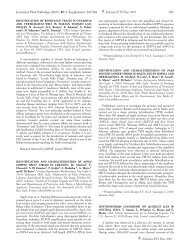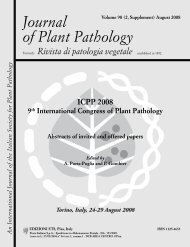S4.104 <strong>Journal</strong> <strong>of</strong> <strong>Plant</strong> <strong>Pathology</strong> (<strong>2010</strong>), <strong>92</strong> (4, <strong>Supplement</strong>), S4.71-S4.105 mined for fourteen isolates collected from different locations in the cotton growing regions <strong>of</strong> Australia. Four gossypol concentration (0, 4, 10 and 20 mg/l) and five FOV isolates (two from each vegetative compatibility group, VCG 01111 and VCG 01112, and a fifth isolate not yet assigned to a VCG) were here considered. Different conidial germination rates were observed over 8 h among the isolates tested. The results are discussed according to the vegetative compatibility group to which the isolates belong and to their different virulence on cotton germoplasm. OPHIOSTOMATOID FUNGI ASSOCIATED WITH IPS ACUMINATUS (COLEOPTERA: CURCULIONIDAE) IN THE ITALIAN ALPS. C. Villari 1 , A. Battisti 1 , P. Capretti 2 , M. Faccoli 1 . 1 Dipartimento di Agronomia Ambientale e Produzioni Vegetali, Università degli Studi di Padova, Agripolis, Viale dell’Università 16, 35020 Legnaro (PD), Italy. 2 Dipartimento di Biotecnologie Agrarie, Sezione di Protezione delle Piante, Università degli Studi, Piazzale delle Cascine 28, 50144 Firenze, Italy. E-mail: caterina.villari@unipd.it Most bark beetles are associated with symbiotic fungi, assisting beetles in killing healthy trees. The Scots pine beetle Ips acuminatus is reported to be associated with Ophiostoma brunneo-ciliatum, O. ips and Ambrosiella macrospora. The first two species are weak blue-stain pathogens thought to be involved in lowering the critical threshold <strong>of</strong> beetle attack density. A. macrospora is a non-pathogenic fungus used as a direct food source for the larvae. This study aims at explaining the role <strong>of</strong> the fungi associated with I. acuminatus in the decline <strong>of</strong> alpine Scots pine stands, exploring the possible quantitative and qualitative variations <strong>of</strong> fungal flora. Epidemic and endemic beetle populations were sampled in early spring 2009 from three sites at each <strong>of</strong> six locations selected across the Italian Alps. Adult beetles were obtained from logs incubated in rearing cages and a subset was washed in 1% Tween 80. The washing solution was then plated on selective medium, in order to isolate and identify the beetle-associated fungi on morphological grounds. Ophiostoma brunneo-ciliatum and O. ips were isolated from both males and females at nearly all sites, while A. macrospora was never isolated, probably because it is difficult to culture. The insect pathogenic fungus Beauveria spp. was isolated with high frequency. No differences were found between epidemic and endemic populations. Molecular markers specific for each fungal species were developed, in order to simplify and speed up the species identification, A. macrospora included, and to compare the fungal communities associated with I. acuminatus among populations. HARZIANIC ACID, A SIDEROPHORE FROM TRICHO- DERMA HARZIANUM WITH ANTIFUNGAL AND PLANT GROWTH PROMOTING ACTIVITY. F. Vinale 1 , G. Flematti 2 , K. Sivasithamparam 3 , E.L. Ghisalberti 2 , R. Marra 1 , M. Ruocco 4 , S.L. Woo 1 , S. Lanzuise 1 , M. Nigro 1 , M. Lorito 1,4 . 1 Dipartimento di Arboricoltura Botanica e Patologia Vegetale, Università degli Studi di Napoli ‘Federico II’, 80055 Portici (NA), Italy. 2 School <strong>of</strong> Biomedical, Biomolecular and Chemical Sciences, University <strong>of</strong> Western Australia, Australia. 3 School <strong>of</strong> <strong>Plant</strong> Biology, The University <strong>of</strong> Western Australia, 35 Stirling Highway, 6009 Crawley, Australia. 4 Istituto di Protezione delle Piante del CNR, Via Università 133, 80055 Portici (NA), Italy. E-mail: frvinale@ unina.it Many strains <strong>of</strong> the fungus Trichoderma are well known producers <strong>of</strong> secondary metabolites having antibiotic activity. Their production varies in relation to: (i) the specific compound; (ii) the species and strain; (iii) the presence/absence <strong>of</strong> other microbes and; (iv) the balance between elicited biosynthesis and biotransformation rates. The involvement <strong>of</strong> secondary metabolites in the ability <strong>of</strong> Trichoderma spp. to activate plant defence mechanisms and regulate plant growth has recently been investigated. A T. harzianum strain, isolated from composted hardwood bark in Western Australia, produces a metabolite that showed antifungal activity in vitro against Pythium irregulare, Sclerotinia sclerotiorum and Rhizoctonia solani. The structure and absolute configuration <strong>of</strong> the fungal metabolite, harzianic acid, was determined by X-ray diffraction studies. The effect <strong>of</strong> harzianic acid on plant growth promotion was evaluated by treating seeds <strong>of</strong> canola (Brassica napus) with different concentrations <strong>of</strong> the purified Trichoderma metabolite and measuring the stem length <strong>of</strong> developing seedlings. Applications <strong>of</strong> the compound at concentrations <strong>of</strong> 100, 10 and 1 ng per seed, stimulated plant growth as indicated by an increase <strong>of</strong> 42%, 44% and 52% <strong>of</strong> stem length, respectively, compared with the untreated control (water). However, this same harzianic acid compound also inhibited plant growth up to 45% and 33% (stem length) when augmented concentrations <strong>of</strong> 100 and 10 µg, respectively, were applied to the seed. Additionally, we have discovered that this tetramic acid is capable <strong>of</strong> binding essential metals such as Fe 3+ with a good affinity, providing an important mechanism for iron solubilization, influencing nutrient availability in the soil environment to other micro<strong>org</strong>anisms and to the plant. EVALUATION OF ANTIFUNGAL ACTIVITY OF “BIO- PROTEGE”, A MIXTURE OF SODIUM BICARBONATE AND SILICIUM DIOXIDE, AGAINST MAJOR POSTHAR- VEST FUNGAL PATHOGENS OF FRUIT AND VEGETA- BLES. K. Youssef 1 , P. Di Primo 2 , M. Coniglione 2 , A. Ippolito 1 . 1 Dipartimento di Protezione delle Piante e Microbiologia Applicata, Università degli Studi “A. Moro”, Via Amendola 165/A, 70126 Bari, Italy. 2 Decco Italia srl, Contrada Barriera, 95032 Belpasso (CT), Italy. E-mail: ippolito@agr.uniba.it In recent years, public demands to reduce pesticide use, stimulated by increased awareness <strong>of</strong> environmental and health issues associated with fungicide residues, as well as the development <strong>of</strong> fungicide-resistant strains <strong>of</strong> pathogens, have created the need to find and develop safe alternative control means. The effectiveness <strong>of</strong> a formulation based on a mixture <strong>of</strong> sodium bicarbonate and silicium dioxide (Bioprotege, Decco Italia) as a possible alternative to synthetic fungicides for controlling postharvest pathogens was evaluated. Bioprotege at increasing concentrations (0, 0.1, 0.2, 0.3, 0.4, 0.5, 1, 2, 4, and 6%, w/v) mixed with potato dextrose agar (PDA) medium was tested. The concentration causing 50% growth reduction (ED 50 , SAS probit analysis) and the minimum inhibition concentration (MIC) values, were also evaluated. The ED 50 was 0.11, 0.10, 0.08, 0.08, 0.25, 0.53, and 1.3% (w/v) for Penicillium digitatum, P. italicum, P. ulaiense, Monilinia laxa, Phytophthora nicotianae, Geotrichum candidum, and Botrytis cinerea, respectively. Complete growth inhibition <strong>of</strong> the same pathogens, except for B. cinerea, was achieved at 0.3, 0.3, 0.2, 0.2, 2, and 2% (w/v), respectively. No MIC was found for B. cinerea since complete inhibition was not achieved till 6%. The effect <strong>of</strong> Bioprotege was primarily fungistatic because when fungal discs showing no growth were re-seeded onto fresh PDA, their growth resumed. Bioprotege confirmed its activity in in vivo trials performed on fuits <strong>of</strong> different citrus species. Overall, the results show the potential benefits <strong>of</strong> Bioprotege for controlling postharvest pathogens attacking fruit and vegetables.
<strong>Journal</strong> <strong>of</strong> <strong>Plant</strong> <strong>Pathology</strong> (<strong>2010</strong>), <strong>92</strong> (4, <strong>Supplement</strong>), S4.71-S4.105 S4.105 RESISTANCE OF MUSKMELON TO FUSARIUM WILT. A. Zechini D’Aulerio, R. Roberti, F. Piattoni, G. Servidio. Dipartimento di Protezione e Valorizzazione Agroalimentare, Università degli Studi, Viale Fanin 46, 40126 Bologna, Italy. E-mail: aldo.zechinidaulerio@unibo.it In Italy, Fusarium oxysporum f. sp, melonis induces an important disease <strong>of</strong> muskmelon. Four races <strong>of</strong> this pathogen are currently known, i.e. 0, 1, 2 and 1-2. Varietal resistance is the only reliable approach for preventing wilt induced by race 0, 1 and 2, which were studied in this work. Investigations carried out between 2008 and <strong>2010</strong> aimed first at verifying the resistance <strong>of</strong> the cultivars certified as “resistant” by seed companies. To this aim, three “resistant” cultivars (Bingo, Giusto and Sweetness) were compared with three susceptible cultivars (Cantalupo, Harper and Retato degli Ortolani), by infecting plants with each <strong>of</strong> the three pathogenic races (spore suspension: 10 6 conidia/ml). Among the “resistant” cultivars, one resulted totally resistant (Bingo), whereas Giusto and Sweetness showed a partial resistance (disease severity: 10%). Similar differences were observed among the susceptible cultivars for disease severity was close to 100% in Retato whereas Cantalupo and Harper it ranged between 80 and 85%. Differences in pathogenicity were also observed among the pathogenic races tested: race 0 and 2 caused the highest disease severity in Bingo and Retato. Attempts were made to investigate the mechanisms involved in plant resistance. We found that root exudates did not affect neither conidial germination rate nor mycelial growth. Currently, studies on the development <strong>of</strong> promycelium are being carried out. Further investigations will aim at highlighting possible differences between resistant and susceptible cultivars, in post-infection root morphological modifications, by means <strong>of</strong> fluorescence microscopy techniques.
- Page 1 and 2: Journal of Plant Pathology (2010),
- Page 3 and 4: Journal of Plant Pathology (2010),
- Page 5 and 6: Journal of Plant Pathology (2010),
- Page 7 and 8: Journal of Plant Pathology (2010),
- Page 9 and 10: Journal of Plant Pathology (2010),
- Page 11 and 12: Journal of Plant Pathology (2010),
- Page 13 and 14: Journal of Plant Pathology (2010),
- Page 15 and 16: Journal of Plant Pathology (2010),
- Page 17 and 18: Journal of Plant Pathology (2010),
- Page 19 and 20: Journal of Plant Pathology (2010),
- Page 21 and 22: Journal of Plant Pathology (2010),
- Page 23 and 24: Journal of Plant Pathology (2010),
- Page 25 and 26: Journal of Plant Pathology (2010),
- Page 27 and 28: Journal of Plant Pathology (2010),
- Page 29 and 30: Journal of Plant Pathology (2010),
- Page 31 and 32: Journal of Plant Pathology (2010),
- Page 33: Journal of Plant Pathology (2010),



